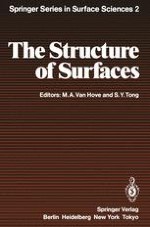1985 | OriginalPaper | Buchkapitel
The Surface Topography of a Pd(100) Single Crystal and Glassy Pd81Si19 Studied by Scanning Tunneling Microscopy
verfasst von : M. Ringger, H. R. Hidber, R. Schlögl, P. Oelhafen, H. J. Güntherodt, K. Wandelt, G. Ertl
Erschienen in: The Structure of Surfaces
Verlag: Springer Berlin Heidelberg
Enthalten in: Professional Book Archive
Aktivieren Sie unsere intelligente Suche, um passende Fachinhalte oder Patente zu finden.
Wählen Sie Textabschnitte aus um mit Künstlicher Intelligenz passenden Patente zu finden. powered by
Markieren Sie Textabschnitte, um KI-gestützt weitere passende Inhalte zu finden. powered by
The methods available to study surfaces [7.1–3] may be divided into techniques which supply spatially resolved information (on the submicron scale) and into the others which yield integral information. Scanning Auger spectroscopy and electron microscopy used as SEM, TEM and STEM are perhaps the most powerful methods among the first group. A principal resolution limit of these techniques is given by the volume of interaction between the electrons of the “light source” and the specimen. This volume will always be larger than the volume of a single atom. Therefore a new microscopic technique which does not require such an interaction zone had to be found in order to reach the ultimate goal of atomic resolution in imaging surfaces. Such a technique is Scanning Tunneling Microscopy (STM) recently developed by Binnig and Rohrer and collaborators [7.4, 5]. We have built a microscope similar to the published design principles.
